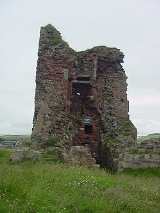
Ardrossan Castle
Encyclopedia
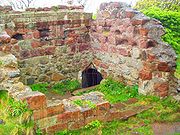
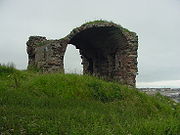
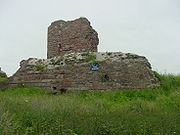
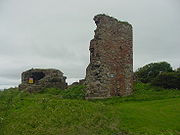
Scotland
Scotland is a country that is part of the United Kingdom. Occupying the northern third of the island of Great Britain, it shares a border with England to the south and is bounded by the North Sea to the east, the Atlantic Ocean to the north and west, and the North Channel and Irish Sea to the...
in the town of Ardrossan
Ardrossan
Ardrossan is a town on the North Ayrshire coast in south-western Scotland. The name "Ardrossan" describes its physical position — 'ard' from the Gaelic àird meaning headland, 'ros' a promontory and the diminutive suffix '-an' - headland of the little promontory...
, Ayrshire
Ayrshire
Ayrshire is a registration county, and former administrative county in south-west Scotland, United Kingdom, located on the shores of the Firth of Clyde. Its principal towns include Ayr, Kilmarnock and Irvine. The town of Troon on the coast has hosted the British Open Golf Championship twice in the...
. The castle, defended by a moat
Moat
A moat is a deep, broad ditch, either dry or filled with water, that surrounds a castle, other building or town, historically to provide it with a preliminary line of defence. In some places moats evolved into more extensive water defences, including natural or artificial lakes, dams and sluices...
, stands on a ridge above the town. There is a keep
Keep
A keep is a type of fortified tower built within castles during the Middle Ages by European nobility. Scholars have debated the scope of the word keep, but usually consider it to refer to large towers in castles that were fortified residences, used as a refuge of last resort should the rest of the...
dating from the fifteenth century, and a vaulted range containing a kitchen and cellars. In a deep passageway there is a well. Part of the keep remains up to the corbels of the parapet
Parapet
A parapet is a wall-like barrier at the edge of a roof, terrace, balcony or other structure. Where extending above a roof, it may simply be the portion of an exterior wall that continues above the line of the roof surface, or may be a continuation of a vertical feature beneath the roof such as a...
, but it is in ruins. The original castle, owned by Clan Barclay
Clan Barclay
-Origins of the clan:Since the eighteenth century, Barclay historians, noted for their low level in medieval scholarship, have assumed the Scottish family Barclay is a branch of one of the Anglo-Norman Berkeley family of Berkeley in Gloucestershire...
, was partly destroyed during the Wars of Scottish Independence
Wars of Scottish Independence
The Wars of Scottish Independence were a series of military campaigns fought between the independent Kingdom of Scotland and the Kingdom of England in the late 13th and early 14th centuries....
. This event, in which the English garrison were slaughtered, became known as "Wallace's Larder," a name which is still applied to the remaining vaults. Rebuilt by Clan Montgomery
Clan Montgomery
-Origins of the Clan:Clan Montgomery originated in Wales, and emigrated to Scotland in the 12th century as vassals of the FitzAlans. The family derives its surname from lands in Wales, likely from the Honour of Montgomery which was located near the Shropshire lands of the FitzAlans...
in the 15th century, Ardrossan later fell into disuse and was demolished by the soldiers of Oliver Cromwell
Oliver Cromwell
Oliver Cromwell was an English military and political leader who overthrew the English monarchy and temporarily turned England into a republican Commonwealth, and served as Lord Protector of England, Scotland, and Ireland....
in the 17th century.
History
Ardrossan Castle is situated upon a rocky hill, which gives it its name, made up of ard, meaning height, and rossan, a rocky promontoryPromontory
Promontory may refer to:*Promontory, a prominent mass of land which overlooks lower lying land or a body of water*Promontory, Utah, the location where the United States first Transcontinental Railroad was completed...
. The present ruins are on the site of an earlier castle owned by the Barclay family. By the thirteenth century it had passed to the Ardrossan family.
The castle has long been deemed a distinctive feature of the city of Ardrossan. It was included, for example, in the tour book from 1847 titled Sylvan's Pictorial Handbook to the Clyde and its Watering-Places by Thomas and Edward Gilks. There the castle is described as a marker of regional identity and subject antiquarian interest, from which beautiful views of the ocean can be seen:
Ardrossan was originally called "Castle Crags", from the nature of the rocks jutting out as they once did from the Cannon hill on which the ruins of the castle stand, behind the present good hotel, the Tontine, and the opposite corner of the main-street, the site of which was once upon the same level. It was subsequently named Ardrossan, after the ancient family who owned the place, and was formerly part of the neighboring parish of Saltcoats. It cams to the present family of Eglintoun, by intermarriage with the Ardrossan family; and they became possessed of the property and inherited the title of Barons of Ardrossan—the tenure being contingent on keeping up the Cannon Hill before mentioned; in default of which the latter titled becomes extinct. Upon the hill six guns are mounted, outside the wall which surrounds the castle grounds. There is a view of a curious ruin from the outside—the shell of a quadrangular tower of great strength, with remaining portions of the walls, which owes its demolition, like many others, to Cromwell; the whole embedded in the surrounding trees. On the outside of the decayed walls are the remains of an old church-yard, containing numerous ruinous tombstones of an interesting character. The view from this eminence of the Isle of Arran to the west, of the beautiful bay to the east, which separates Ardrossan from Saltcoats—and immediately beneath, on the other side, the “Horse Island,” is peculiarly striking. (pages 97-99)
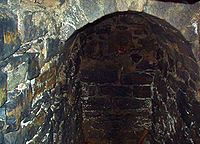
Wallace's larder
In 1292, under the reign of John Balliol, the castle fell to the invading EnglishKingdom of England
The Kingdom of England was, from 927 to 1707, a sovereign state to the northwest of continental Europe. At its height, the Kingdom of England spanned the southern two-thirds of the island of Great Britain and several smaller outlying islands; what today comprises the legal jurisdiction of England...
army under Edward I
Edward I of England
Edward I , also known as Edward Longshanks and the Hammer of the Scots, was King of England from 1272 to 1307. The first son of Henry III, Edward was involved early in the political intrigues of his father's reign, which included an outright rebellion by the English barons...
, who held it until 1296. In that year, William Wallace
William Wallace
Sir William Wallace was a Scottish knight and landowner who became one of the main leaders during the Wars of Scottish Independence....
and his men set fire to a nearby building outside the castle. One by one the English ran out from the drawbridge
Drawbridge
A drawbridge is a type of movable bridge typically associated with the entrance of a castle surrounded by a moat. The term is often used to describe all different types of movable bridges, like bascule bridges and lift bridges.-Castle drawbridges:...
, and were taken by Wallace as they passed. The bodies of the dead and those still living were then thrown into the vaults below the castle. After all the Englishmen had been squeezed into the vault, the garrison's food supplies were thrown down on top of the bodies. The men and foodstuffs were left to rot there, and the castle was then partly dismantled. During excavation work in 1829, a ring was discovered at the site, engraved with the letter ‘W’ and is said to have belonged to Wallace.
A similar event took place in 1307 when Sir James Douglas
James Douglas, Lord of Douglas
Sir James Douglas , , was a Scottish soldier and knight who fought in the Scottish Wars of Independence.-Early life:...
stormed Douglas Castle
Douglas Castle
Douglas Castle was a stronghold of the Douglas family from medieval times to the 20th century. The first castle, erected in the 13th century, was destroyed and replaced several times until the 18th century when a large mansion house was built in its place. This too was demolished in 1938, and today...
, killing an English garrison and slighting
Slighting
A slighting is the deliberate destruction, partial or complete, of a fortification without opposition. During the English Civil War this was to render it unusable as a fort.-Middle Ages:...
the castle.
Later history
The castle was acquired by Sir John Montgomery (who captured Harry Hotspur Percy at the Battle of OtterburnBattle of Otterburn
The Battle of Otterburn took place on the 5 August 1388, as part of the continuing border skirmishes between the Scottish and English.The best remaining record of the battle is from Jean Froissart's Chronicles in which he claims to have interviewed veterans from both sides of the battle...
) and he remodeled it. His son became Lord Montgomery in about 1445, and his son in turn became the first Earl of Eglinton
Earl of Eglinton
Earl of Eglinton is a title in the Peerage of Scotland.Some authorities spell the title: Earl of Eglintoun In 1859 the thirteenth Earl of Eglinton, Archibald Montgomerie, was also created Earl of Winton in the Peerage of the United Kingdom, which gave him an automatic seat in the House of Lords,...
. The family sheltered in the castle after the Cunningham
Clan Cunningham
Clan Cunningham is a Scottish clan. The clan does not currently have a chief, therefore it is considered an Armigerous clan by the Standing Council of Scottish Chiefs, though recently two contenders for the chiefship have emerged...
s sacked their castle at Eglinton
Eglinton Castle
Eglinton Castle was a large Gothic castellated mansion in Kilwinning, North Ayrshire, Scotland.-The castle :The ancient seat of the Earls of Eglinton, it is located just south of the town of Kilwinning...
, Ayrshire. Afterwards it fell into disuse.
The castle remained until 1648, when Oliver Cromwell
Oliver Cromwell
Oliver Cromwell was an English military and political leader who overthrew the English monarchy and temporarily turned England into a republican Commonwealth, and served as Lord Protector of England, Scotland, and Ireland....
's troops destroyed it, removing much of the stone and taking it to Ayr
Ayr
Ayr is a town and port situated on the Firth of Clyde in south-west Scotland. With a population of around 46,000, Ayr is the largest settlement in Ayrshire, of which it is the county town, and has held royal burgh status since 1205...
to build a fort there. The ruins of the castle still stand, but are in hazardous condition.
Legends
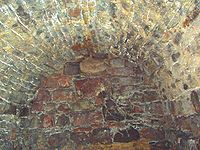
The castle is also associated with the Devil
Devil
The Devil is believed in many religions and cultures to be a powerful, supernatural entity that is the personification of evil and the enemy of God and humankind. The nature of the role varies greatly...
. Sir Fergus Barclay, also known as "the De'il of Ardrossan", was a horseman, famous around the lands for his tremendous skill. The secret to his skill, however, was a magical bridle
Bridle
A bridle is a piece of equipment used to direct a horse. As defined in the Oxford English Dictionary, the "bridle" includes both the headstall that holds a bit that goes in the mouth of a horse, and the reins that are attached to the bit....
, which was given to Barclay by the Devil, in exchange for his soul. However, the Devil was tricked by Barclay into giving his soul back. Infuriated by this trickery, the Devil attacked the castle in his rage, and is said to have left his hoof prints on one of the rocks. Sir Fergus Barclay is buried in the castle chapel
Chapel
A chapel is a building used by Christians as a place of fellowship and worship. It may be part of a larger structure or complex, such as a church, college, hospital, palace, prison or funeral home, located on board a military or commercial ship, or it may be an entirely free-standing building,...
, situated a few hundred yards inland from the castle, further down the hill.
tourist info
The surviving parts of Ardrossan Castle stand on the south side of Castle Hill, above slopes that descend steeply to the railway line below. Its location means that the castle is prominent in views across South Bay from Saltcoats, and from much of the southern end of Ardrossan itself, though its existence is far from obvious from the northern half of the town.The castle carries signs warning not to approach it too closely, and though someone has at sometime consolidated the ruins, we'd share the recommendation to take great care when viewing them.
The ruins today comprise two main sections. The remains of the keep, built in the 1400s, form the most striking standing element. These rise in part to the third storey, though on the south side are completely open, revealing interior fixtures like fireplaces and some very weathered carved stonework. The continuation of the range including the keep contains a cellar whose entrance is blocked by railings. The second main element of the castle is part of the south range, apparently a vaulted structure in which a section of the cellar now forms a short vaulted tunnel.
A castle was first built on this site by Simon de Morville, probably in about 1140. By 1226 the laird was Richard Barclay de Ardrossan. During the Wars of Independence Ardrossan Castle was held by English forces for Edward I until captured by William Wallace. Wallace is said to have largely destroyed the castle and slaughtered the English garrison, dumping their bodies in a cellar, which later became known as "Wallace's Larder".
In 1357 the last of the direct Barclay line, Godfrey Barclay de Ardrossan, died without successors. The castle and estate subsequently passed by marriage to the Eglinton family. In the 1380s Sir John Montgomery, the 7th Baron of Eaglesham, married the heiress of Sir Hugh Eglinton and so became Baron of Eglinton and Ardrossan. Montgomery subsequently enlarged and remodelled Ardrossan Castle.
Much of the structure whose remains can be seen today dates back to a further remodelling and rebuilding of the castle which took place after Sir John's grandson was made Lord Montgomery in 1449. The castle briefly became the main home of the Montgomery family after Eglinton Castle was attacked and burned down by the Cunninghams in 1528, but afterwards seems to have been allowed to decline. In 1654, troops from Cromwell's army of occupation removed much of the stone from Ardrossan Castle for reuse in the building of their citadel at Ayr, leaving only partial remains which have since served as a point of interest for visitors to Ardrossan.

